If you own a dog, you may have wondered why your pet spends so much time sleeping.

Is excessive sleep in dogs normal? What effect does sleep have on their health and behavior? What do their sleeping arrangements mean? Based on the most recent research and expert viewpoints, we will address these questions and more in this post.
Contents
How Much Do Dogs Sleep?
Pooches rest more than individuals do. On average, dogs require approximately 12 to 14 hours of rest a day. Enormous pooches tend to require longer rests than littler pooches[1].
Puppies require almost 18 to 19 hours of rest a day, as a rule, waking up for an hour after each few hours of rest. Take note of your dog’s typical resting propensities.

The amount of rest that mutts require depends on a few components, such as their age, breed, action level, and environment.
More seasoned dogs and bigger breeds tend to rest more, as they have less vitality and require more time to recover.
Working puppy breeds, such as border collies and German shepherds, are more dynamic and regularly rest less than other breeds.
Mutts also rest less when they have a great reason to be dynamic, such as work, play, or incitement.
How Does Sleep Affect a Dog’s Health?
Rest is basic for a dog’s wellbeing. Rest makes a difference. Mutts keep up their safe framework, memory[2], learning capacity, and temperament.
Rest hardship can antagonistically influence dogs, making them more inclined to wellbeing issues and destitute temperaments.
Some of the benefits of sleep for dogs are:
- Immune system
Rest makes a difference Mutts battle off contamination and maladies by boosting their safe framework. A need for rest can debilitate their resistant framework and make them more vulnerable to sickness.

- Memory and learning
Rest makes a difference Dogs solidify their memories and learn modern aptitudes. Amid rest, pooches prepare the data they obtained during the day and store it in their long-term memory. This makes a difference in their execution and behavior.
According to psychologist and leading canine researcher Dr. Stanley Coren, about dog memory and Behaviour, “There are three types of dog intelligence: instinctive (what the dog is bred to do), adaptive (how well the dog learns from its environment to solve problems) and working and obedience (the equivalent of ‘school learning’).” and “dogs’ mental abilities are close to a human child age 2 to 2.5 years.“
- Mood
Rest makes a difference Mutts direct their feelings and adapt with stretch. A great night’s rest can make mutts more joyful and more loose. An awful night’s rest can make mutts crabby and on edge.
“Canines lack complex feelings such as contempt, guilt, pride, and shame” says Dr. Stanley Coren, PhD, psychologist and author of How Dogs Think.
How Do Dogs Sleep?
Dogs follow distinct sleeping patterns[3] that are similar to those of people. When dogs first fall asleep, they enter the quiet stage of sleep, where breathing slows, blood pressure drops, and heart rate decreases.

In the active stage of sleep, dogs move their eyes rapidly under closed eyelids. This is known as REM (Rapid Eye Movement) sleep. Dogs spend only 10 percent of their sleep in REM, compared to 25 percent for humans.
This means that dogs need to sleep more often to get enough REM sleep. REM sleep is important for dogs because it is when they dream. Dogs often dream about common dog activities, such as chasing squirrels or playing with toys.
You may see your dog’s legs twitch or hear muffled barks as they dream[4].
What Do Dog Sleeping Positions Mean?
Dogs often sleep in different positions, depending on how they feel and what they need. The position your dog chooses for sleeping may reveal something about their personality, health, and comfort level.
Here are some common dog sleeping positions and what they mean:
Sleeping on their side
This is a sign of trust and relaxation. A dog that sleeps on its side exposes its most vulnerable regions, which means it feels safe and comfortable in its environment.
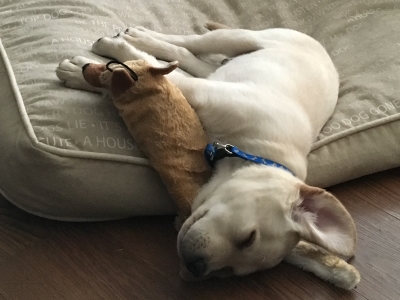
Side sleeping is generally a sign of deep sleep.
Sleeping on their stomach
This is a symptom of mild dozing. A dog that sleeps on its stomach with its legs splayed out is ready to leap up at any time.
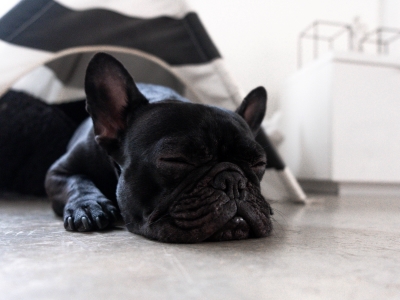
This stance is common in puppies and dogs who want to play.
Sleeping on their back
This may have two implications. A canine that rests on its back with its paws in the air either feels exceptionally secure in its environment or is attempting to cool down.

Since the hide on their stomachs is more slender than their backs, a canine resting on its back may be attempting to regulate its body temperature.
According to Dr. Alex Schechter, “The average body temperature for a dog ranges between [approximately] 99.5 and 102.5 degrees Fahrenheit.”
Sleeping curled up
This is a sign of protection and warmth. A dog that sleeps curled up in a ball is conserving its body heat and shielding its vital organs from potential threats.
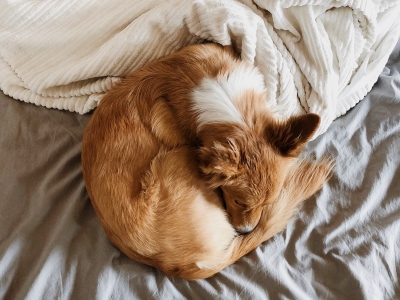
This position is common among dogs that live in cold climates or have been abused or neglected.
Sleeping with others
This can be a sign of social acceptance and warmth. A canine that rests with other dogs or people is showing its love and devotion.
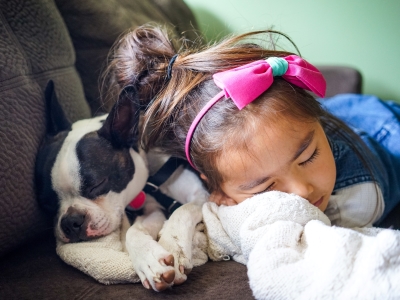
This position also provides warmth and security for the pooch.
When Should You Be Concerned About Your Dog’s Sleeping Habits?
Although it is normal for dogs to rest, there are a few circumstances where you ought to be concerned about your dog’s resting propensities.
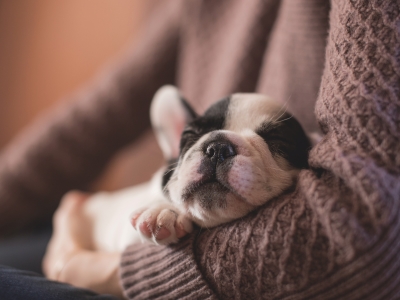
In the event that you take note of any of the following signs, you ought to consult your veterinarian:
- Excessive sleepiness
If your canine rests more than usual or appears dormant and uninterested in its environment, it may be a sign of a basic wellbeing issue, such as iron deficiency, hypothyroidism, diabetes, or kidney illness.
- Insomnia
If your dog has difficulty sleeping or staying asleep, this might be an indication of stress, worry, pain, or discomfort.
Noise, temperature, parasites, allergies, and medical issues are all potential reasons for canine sleeplessness.
- Sleep apnea
If your dog snores loudly or stops breathing during sleep, it may have sleep apnea. Sleep apnea is a condition where the airway becomes blocked or collapses during sleep, causing the dog to wake up repeatedly.
Sleep apnea can affect any breed of dog, but it is more common in brachycephalic breeds[6], such as bulldogs and pugs.
How to Help Your Dog Sleep Better
If you want to help your dog sleep better, there are some things you can do to improve their sleeping environment and routine.
Here are some tips to help your dog sleep better:
- Provide a comfortable bed
Make sure beyond any doubt that your puppy has a cozy and clean bed that suits its size and inclinations. A few mutts like delicate and soft beds, while others lean toward firm and level ones. You’ll also want to include a few covers, pads, or toys to make the bed more welcoming.
- Keep a consistent schedule
Try to keep a regular routine for your dog’s feeding, exercise, and bedtime. This will help your dog establish a natural sleep cycle and avoid disruptions. Avoid feeding your dog too late at night or giving them caffeinated or sugary treats before bed.

- Reduce noise and light
Minimize any sources of clamor and light that will disturb your dog’s rest. You’ll be able to use curtains, blinds, or shades to block any outside light.
You’ll be able too utilize white noise machines, fans, or delicate music to cover any undesirable sounds.
- Exercise your dog
Make it beyond any doubt that your pooch gets sufficient physical and mental stimulation throughout the day. This will help your canine burn off excess vitality and diminish stress and boredom[7].
A tired dog is more likely to rest well at night.
- Consult your veterinarian
In case you’ve got any concerns regarding your dog’s resting propensities or wellbeing, you ought to continuously counsel your veterinarian.
They can diagnose any potential issues and endorse the leading treatment for your canine.
FAQs
How can I tell if my dog is getting enough sleep?
You’ll know on the off chance that your puppy is getting sufficient rest by watching their behavior and vitality level. In the event that your puppy is well-rested, they ought to be cautious, lively, and responsive. If your canine is sleep-deprived, they may be sluggish, touchy, or defiant. You’ll be able too screen your dog’s resting plan and compare it to the normal amount of rest that mutts require.
What are some of the best sleeping positions for dogs?
There’s no conclusive reply to what the leading resting positions are for mutts, as diverse positions may suit diverse mutts depending on their personality, health, and consolation level.
Be that as it may, a few common rules are to supply your puppy with a comfortable and clean bed that bolsters their body and joints, to maintain a strategic distance from setting your canine in a position that limits their breathing or circulation, and to regard your dog’s inclinations and choices.
How can I make my dog’s dreams more pleasant?
You’ll be able to make your dog’s dreams more charming by giving them positive encounters and stimuli during the day. For illustration, you’ll be able to play with them, laud them, grant them treats, or expose them to modern sights and smells. This will help them relate great sentiments to their recollections and dreams.
Is it normal for my dog to sleep a lot during the day?
Yes, dogs sleep a significant portion of the day, typically ranging from 12 to 16 hours, depending on factors like age, breed, and activity level. Puppies and seniors tend to sleep even more.
Can a change in weather affect my dog’s sleep pattern?
Yes, extraordinary temperatures can influence your dog’s rest. Mutts regularly look for warmth in colder climates and may rest more on hot days. Provide a comfortable and climate-appropriate resting environment.
Conclusion
Dogs are astonishing animals that require a part of rest to remain solid and cheerful.
By understanding their resting designs and positions, you’ll be able learn more approximately their identity and well-being.
By giving them with a comfortable and consistent sleeping environment and schedule, you’ll be able offer assistance them rest way better and appreciate their dreams.
Reference:
- How many hours does a dog sleep in a day? | PetMD
- Your dog remembers more than you think| American Kennel Club
- Understanding your dog’s sleeping patterns | Akcreunite
- Do Dogs Dream? | VCA Animal Hospitals
- Brachycephalic Dog Breeds: A Guide to Flat-Faced Dogs | American Kennel Club
- Healthy exercise for dogs | VCA Animal Hospitals

Dania is a dog groomer living in California, who loves styling dogs. She often uses dog accessories to keep them distracted while grooming. She is also a dog parent to a Pomeranian, Duke. It’s because of him she is always on a lookout for the best dog foods, toys, other dog accessories, and ways to keep him equipped, healthy and happy.


